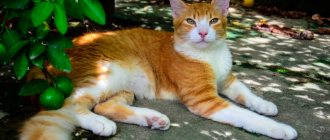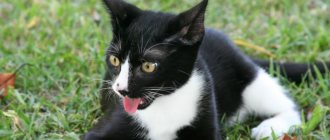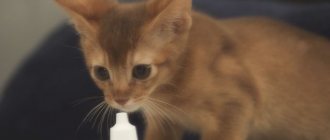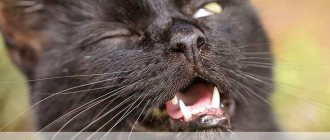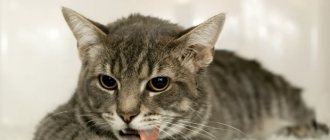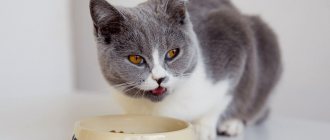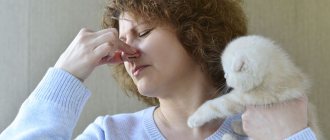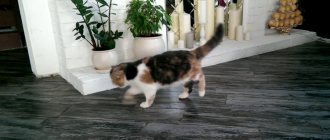Pets breathing is normal
The respiratory process of mustachioed pets is similar to that of humans. When you inhale, air enters the nose and travels through the respiratory tract to the lungs. The carbon dioxide remaining after processing is removed along a similar route, but in reverse order.
An adult cat takes 20-40 breaths per minute, and a kitten takes 40-50. The breathing of a healthy animal is practically not audible, but its presence can be determined by the evenly and smoothly descending pectoral muscles.
Types of shortness of breath
As mentioned above, shortness of breath in a cat can be physiological or pathological.
In turn, pathological shortness of breath, based on the type of breathing disorder, can be divided into the following types:
- bradypnea - slow breathing when the functions of the respiratory center are suppressed;
- tachypnea - rapid shallow breathing. This is a characteristic symptom of fever, as well as anemia and other blood diseases.
In addition, there are several forms of shortness of breath, depending on which phase of breathing is disturbed:
- inspiratory dyspnea - the inspiratory phase is disrupted;
- expiratory shortness of breath - the expiratory phase is disturbed;
- mixed shortness of breath - both inhalation and exhalation are complicated.
Why is a cat breathing heavily and frequently: non-dangerous reasons
Tachypnea, or rapid, heavy breathing, occurs in a cat when there is a lack of oxygen, or hypoxia. This condition is explained by 2 reasons: physiological and pathological.
Physiological causes are not life-threatening. These include various external and internal factors:
- Heat. A pet can overheat outside on a hot day or in a stuffy room with poor ventilation.
- Eating food quickly. Characteristic in the absence of saturation and prolonged fasting. Due to the too rapid absorption of food, breaths are taken in fits and starts, so the oxygen supplied with them is not enough.
- Fatigue after high physical activity. When performing intense movements, muscles require more oxygen, which is why shortness of breath often occurs while running.
- Overexcitement due to fear or aggression. In a state of stress, the body actively produces adrenaline, which speeds up the heart and the frequency of breathing. After calming down, the alarming symptoms disappear on their own.
- Hormonal changes. Occurs during estrus, pregnancy and childbirth. Treatment in these cases is not required, provided that the rest of the condition remains normal.
The risk group includes older cats and overweight cats. They get tired faster and often suffer from obesity due to inactivity.
Respiratory process of a cat
A cat's breathing directly depends on its physical and psychological state. A healthy cat does not wheeze, breathes evenly, calmly, and inaudibly. If problems arise, she is unable to draw air into her lungs and her sighs become intermittent, as if coming from the “stomach.” There are a number of factors that influence the frequency of the process, in which there is no point in worrying too much:
- Stress due to rage, fear, joyful excitement - the frequency increases for a short time.
- Often a kitten wheezes when breathing if it has swallowed its own fur.
Also, do not forget why a kitten wheezes when breathing when he falls asleep soundly. This indicates complete relaxation. At the same time, his pulse and heart beats many times faster than that of an adult.
Heavy breathing in cats and cats is an alarming sign
With pathological causes, the problem lies in internal disorders, fraught with life-threatening complications. The cat is not only breathing heavily with its stomach, but it also looks unwell. The danger of the condition can be determined by the accompanying symptoms.
The main signs that a cat is suffocating
Suffocation caused by lack of oxygen is difficult to miss. It is accompanied by the following symptoms:
- shortness of breath;
- rapid heartbeat;
- general weakness;
- wheezing and sniffling;
- tachycardia;
- cough.
Most often, breathing problems occur in brachycephalic cats, that is, breeds with a flat face. Due to the specific structure of the skull, their nasal passages are narrower and shorter. Such animals inhale a more limited air flow throughout their lives and are much more susceptible to diseases affecting the respiratory tract.
Associated symptoms
In case of health problems, accompanying symptoms are added to the main symptoms. They depend on the cause of the ailment:
- Infectious diseases of the respiratory system (tracheitis, pneumonia, bronchitis). Lack of air occurs due to the active production of leukocytes, which clog the airways in the form of mucus. In addition to discharge from the eyes and nose, gastrointestinal upset (diarrhea, vomiting) and fever are noted.
- Injuries to the spine, ribs and respiratory system. The resulting fragments pinch the lungs, preventing them from fully opening. The cat experiences severe pain when touched or on a constant basis. With internal bleeding, blood comes out along with phlegm.
- Entry of a foreign body into the respiratory tract. Swallowing or inhaling foreign objects is accompanied by severe coughing, sneezing, salivation and lacrimation. Vomiting is also possible.
- Lungworms. These parasites lead to coughing, sneezing and internal bleeding.
- Neoplasms of various nature. Tumors in the respiratory tract interfere with the natural circulation of oxygen. The animal often coughs, wheezes and swallows saliva with effort. In the presence of oncology, there is an increase in sleep time, general weakness, weight loss and deterioration in coat quality.
- Cardiovascular diseases. The circulation of oxygen through the bloodstream occurs thanks to the heart, so any disruption in its functioning leads to difficulty breathing. From a lack of oxygen, the skin turns white and the mucous membranes turn blue. In severe cases of the disease, foam sometimes comes out of the mouth, and the cat itself may lose consciousness.
- Pulmonary edema. Develops as a result of injuries, heart pathologies, kidney and liver diseases. Accompanied by apathy, refusal to eat, blanching of the mucous membranes and noisy gurgling inside the chest.
- Poisoning. The body gets rid of toxins through vomiting and diarrhea. If strong poisons are swallowed, convulsions and pulse disturbances are possible.
Due to the overlap of some symptoms, making an accurate diagnosis on your own is very problematic. Without timely treatment, all of the diseases described above can lead to death from hypoxia, so if you suspect a pathology, it is better to immediately contact a veterinarian.
Asthma in pets
Another possible cause of periodic asthma attacks is asthma. It is easily recognized by a lingering cough. During the next exacerbation, the animal crouches to the floor and stretches its neck. This position is very similar to regurgitation of hairballs, so the disease is often ignored in the initial stages.
In most cases, the source of feline asthma remains unknown. Because of this, animals have to take medications on an ongoing basis. Glucocorticosteroids are most often used to suppress hypersensitivity of the upper respiratory tract.
The most common diseases:
- excessive weight (obesity) - the cat breathes with its mouth open even after minor physical activity;
- allergic reactions, asthma (accompanied by coughing, sneezing, swelling of the larynx);
- infectious diseases (for example, bronchitis if the cat has a fever and cough);
- various pathologies of the internal organs of the chest and abdominal cavity (then the cat breathes with its “stomach”).
There are many accompanying symptoms, and you should carefully monitor the animal to inform the veterinarian of all the details. In such serious cases, only a specialist will make the correct diagnosis and prescribe treatment.
How to provide first aid to a choking pet
First aid methods depend on the cause of the illness. In case of short-term disturbance, breathing often normalizes on its own, but in case of long-term disturbance, followed by cardiac arrest, the animal may require artificial respiration and indirect massage.
Basic steps
For physiological reasons, the pet simply needs to be given time to catch its breath and calm down. If overheating is to blame, be sure to offer a bowl of water and cool the areas where large vessels pass (neck, inner thighs, groin) with a cold compress. It is also recommended to open all doors and windows to create a draft.
If the cat is breathing heavily and wheezing, carefully examine his throat and check the integrity of the ribs. If you find a foreign body or injury, go to the veterinary clinic immediately. Self-help can result in accidentally pushing the found bone or other object even deeper, so it’s better not to take risks here.
Thus, the main actions are limited to normalizing body temperature, ventilating the room and calming the animal. The only exception is sudden cardiac arrest, as well as poisoning, provided its cause is known.
Is it possible to do artificial respiration?
If a cat loses consciousness and does not respond to light, then it requires urgent resuscitation. The rescue operation must begin within 2-3 minutes after the heart has stopped. In such a critical situation, it is very important not to panic, immediately call a veterinarian at home, and then strictly follow the following algorithm:
- Place the animal on its right side and extend its neck in line with the body. This will facilitate air flow.
- Clean the oral cavity from accumulated secretions with a napkin or gauze and close the mouth tightly. Removing mucus will help your pet avoid choking once breathing returns to normal.
- Inhale more air, place your curled palm on the cat’s nose and gently exhale into his nostrils. The frequency of inhalations depends on the size of the animal. With average settings, 20 times per minute is enough. The kitten will need more frequent but less intense repetitions.
- Check your pulse every 20 seconds. When breathing stops, the heart temporarily continues its work, so indirect massage is not required in all cases. If the heartbeat has really stopped, move on to the next step.
- Place one hand on the cat's chest, holding it between the thumb and the other four fingers.
- Perform several quick and rhythmic pressing movements with a break of 5 seconds, remembering to alternate them with artificial respiration. For every 30 movements there should be 2 breaths.
If possible, the rescue operation is best carried out in pairs. Once the heartbeat resumes, the animal cannot be moved, so at this point you just need to wait for the veterinarian.
How can I help at home?
The cat needs to be kept calm and not create additional stress on the respiratory system (it is vitally important not to agitate the cat, this can be very dangerous!). Under no circumstances should you try to put the cat down or give it water - this can be dangerous.
There is no need to use any drugs that stimulate breathing - in most cases this is not only pointless, but can also be harmful. It is necessary to take the animal to the doctor as quickly and carefully as possible.
When is a vet visit necessary?
If you have certain symptoms, it is better not to waste time on self-examination. These include:
- rapid deterioration of the condition or lack of improvement within 3 hours;
- severe wheezing and gurgling in the chest;
- the appearance of pain when touching or coughing, accompanied by a plaintive meow;
- copious discharge of mucus from the nose or mouth;
- pale or blue discoloration of the skin and mucous membranes;
- increase or decrease in heart rate;
- convulsions;
- loss of consciousness.
Particular attention should be paid to children, elderly and pregnant animals. If the kitten is breathing heavily, then it should be taken to the veterinary clinic even in the absence of the listed symptoms. Due to fragile immunity, pets often get sick with complications up to a year old, so in such a situation it is better to play it safe.
In addition to visual inspection and palpation (palpation), a blood test, ultrasound, x-ray and ECG may be required to make a diagnosis. The list of medications will depend on the pathology found:
- antibiotics and antivirals that fight infectious agents;
- anthelmintics that destroy parasites;
- cardiotonics and vasopressors, which reduce the volume of circulating blood and increase the force of heart contraction;
- diuretics, facilitating the removal of excess fluid;
- glucocorticosteroids, eliminating allergies and inflammatory processes;
- sorbents that stimulate the removal of toxins.
In case of poisoning, an antidote may be required. Surgery is used when injuries, deep-lying foreign bodies and neoplasms are detected. If at the time of treatment the cat is in serious condition, then it can be placed in an oxygen chamber.
Diagnostic methods
Rhinitis is diagnosed by nasal congestion, discharge and sneezing. Diagnosing the root causes is becoming more difficult:
- You need to collect a complete medical history, which is almost impossible if you adopted a cat from a shelter or adopted it on the street.
- If the symptomatic picture and tests are not enough, the veterinarian conducts a full examination (the cat is first placed under anesthesia).
During the examination, the veterinarian must ensure that:
- The cat does not have congenital defects in the structure of the skull and nose.
- There is no fistula in the septum between the nose and mouth.
- There are no foreign objects in the cat's nose.
Because nasal congestion can be caused by swelling and injury, your doctor may recommend an X-ray or MRI.
Diagnostic measures
A loving owner always knows the normal breathing rate of his cat. It is slightly different for each animal. Such indicators are determined individually, in the process of observing a calm cat.
Home diagnostics of a pet's breathing is carried out when the animal lies on its side, its stomach rises (inhale) and falls (exhale) steadily. It is necessary to count how many breaths are taken in 1 minute. The counting is repeated 2–3 times. Average values are considered normal for this cat.
The respiratory rate of the animal is compared with the obtained figures when there is a suspicion of disease. This diagnosis determines the severity of the cat’s condition and helps the veterinarian in identifying pathology.
Professional
After talking with the cat owner and examining the animal, the veterinarian sends the furry patient for tests. As a rule, the following are required: biochemical blood data, ultrasound (heart, chest), X-ray results of the neck, chest. If you suspect anemia or diabetes, you will need to test your pet's urine.
Advanced diagnostics include studies of the animal’s bronchi, CT, and rhinoscopy. Sometimes hormonal tests are also necessary.
When diagnosing pathology, the exclusion method is used. This means that from all possible diagnoses diseases that do not coincide with the test data of the furry patient are excluded.
